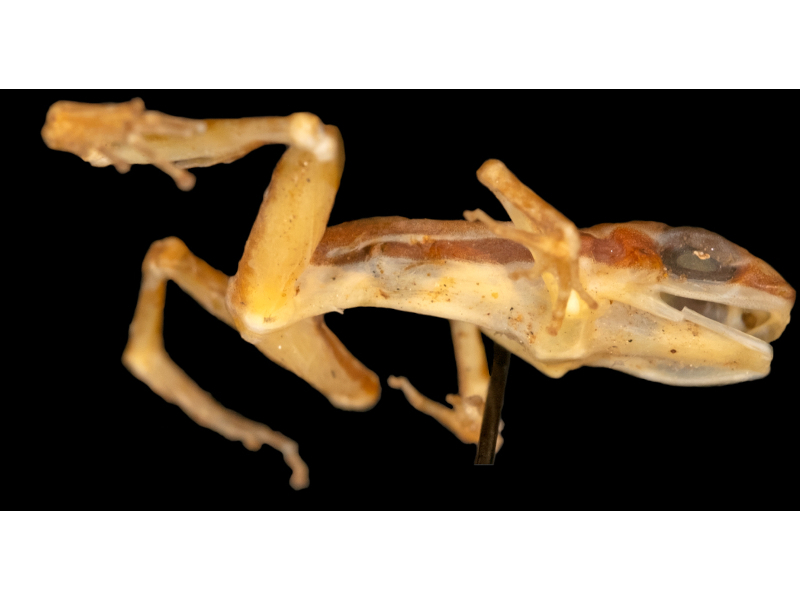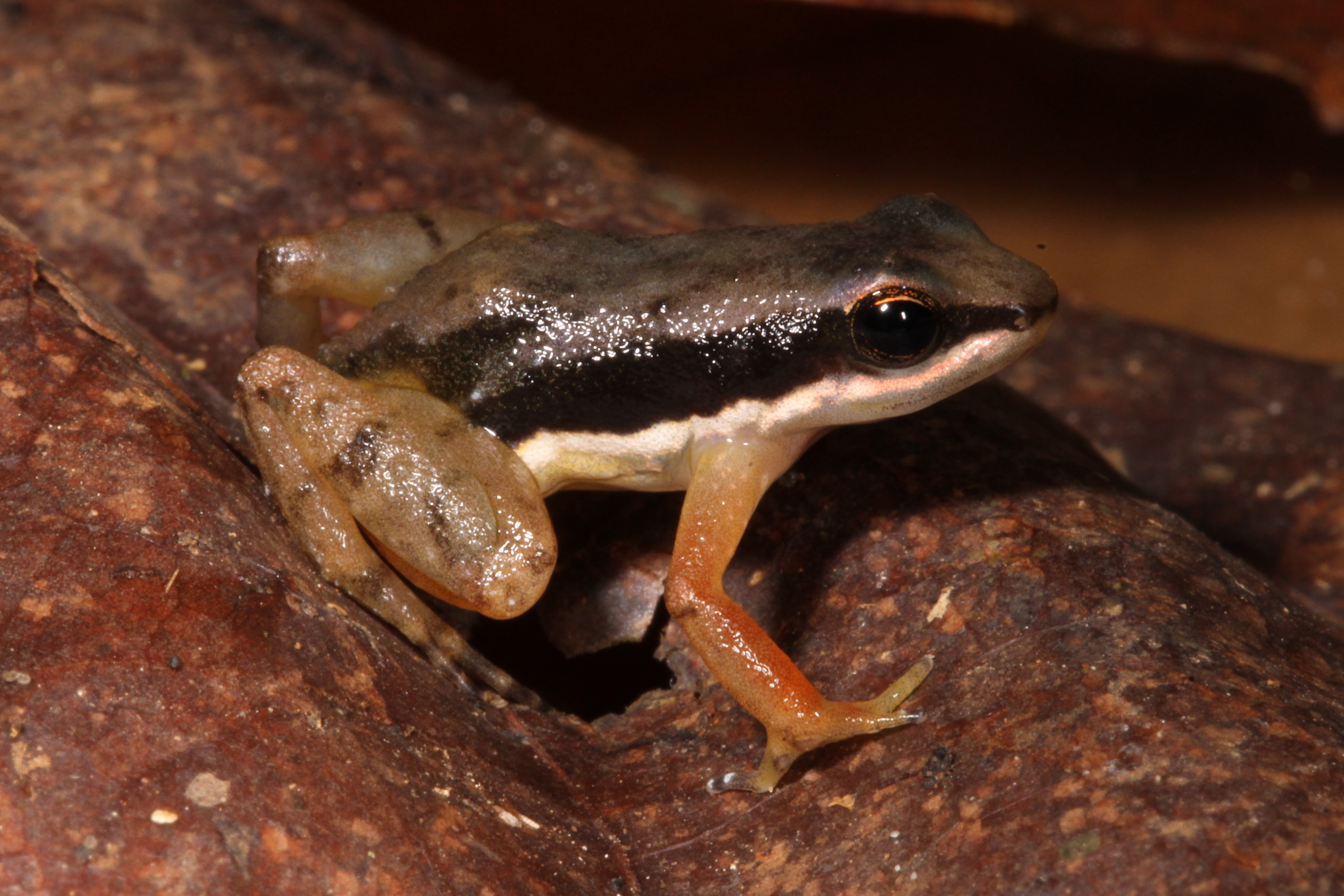

Despite being quite dried out, the only known specimen of the animal allowed it to be identified as a new species to science (photo: Taran Grant/IB-USP)
The dried specimen of the amphibian, collected by herpetologist Doris Cochran in 1963 in what is now a residential neighborhood of Curitiba, Brazil, is stored in the collection of the Smithsonian Institution’s National Museum of Natural History in the United States.
The dried specimen of the amphibian, collected by herpetologist Doris Cochran in 1963 in what is now a residential neighborhood of Curitiba, Brazil, is stored in the collection of the Smithsonian Institution’s National Museum of Natural History in the United States.

Despite being quite dried out, the only known specimen of the animal allowed it to be identified as a new species to science (photo: Taran Grant/IB-USP)
By André Julião | Agência FAPESP – Anyone walking through the Tarumã neighborhood in Curitiba (the capital of the state of Paraná, Brazil) today may find it difficult to imagine the area as it was in the past. Between the buildings, racetrack, and the city’s largest shopping mall, streams, open fields, and wetlands once existed. Back in the 1960s, the area was home to an abundance of biodiversity. In a study supported by FAPESP, researchers described a species of rocket frog that lived in the area. Although it is new to science, the species is probably extinct in the wild.
In a study published in the journal Zootaxa, researchers from the University of São Paulo (USP) in Brazil and the Smithsonian Institution in the United States described the new species, which was named Dryadobates erythropus based on a single specimen collected by American herpetologist Doris M. Cochran (1898-1968) in 1963 during a visit to Brazil with entomologist Doris H. Blake (1892-1978).
The only known specimen of the frog is quite dried out and is housed in the collection of the Smithsonian Institution’s National Museum of Natural History (NMNH-SI) in Washington D.C. in the United States, where Cochran worked for nearly 50 years.
The new species, whose individual is about 14 millimeters long, is considered “probably extinct” because no other specimens have been found in the wild or deposited in natural history museums. It belongs to the recently described genus Dryadobates, which has at least 13 species, seven of which have already been described; four of those species became extinct between the 1960s and 1980s (read more at agencia.fapesp.br/55323).
“The living species of this genus are diurnal frogs, quite abundant, which would be easy to find in the wild. Given that the habitat of D. erythropus has been destroyed and that no other specimen has been collected in extensive surveys in various locations in São Paulo and Paraná over the last 60 years, it’s most likely extinct,” explains Taran Grant, a professor at the Institute of Biosciences (IB) at USP and the first author of the study.
Grant co-authored the paper with Paulo Durães Pereira Pinheiro, currently a researcher at the NMNH-SI who received a postdoctoral fellowship from FAPESP until 2023.
Dryadobates comes from Dryades, a nymph in Greek mythology. Naturalist von Martius gave this name to the Atlantic Forest in his work Flora Brasiliensis. The suffix “bates” means “one who walks.” Erythropus refers to “red foot,” the nickname given to rural workers who worked barefoot on the reddish soil characteristic of northern Paraná.
Three other species of the genus had already been named after the states where they were found: D. alagoanus, D. carioca, and D. capixaba; the latter two are apparently extinct.

Dryadobates bokermanni, which lives in southern Bahia, is one of seven described species of the same genus, which may have 13 in total (photo: Taran Grant/IB-USP)
Field diary
To determine the precise location where the frog was collected, Grant consulted other records in addition to the information written on the label attached to the animal. The Smithsonian Institution, with which the museum is affiliated, has a large archive dedicated to its researchers.
In the material referring to Cochran, Grant found her travel diary from Brazil. The document was essential in determining the animal’s location. Grant explains, “Based on what we knew about the distribution of this group, when we saw the reference to Curitiba, we thought it might have been confused with an animal collected in Rio de Janeiro, where it had been before.”
However, the animal’s characteristics do not match those Cochran described as having been collected in a lagoon and on its banks in Rio de Janeiro. In contrast, the Tarumã notes from January 9, 1963, clearly state that two frogs were captured in a “large field full of anthills and cow-chewed bushes.”
The location of the described frog is now about 550 kilometers south of the closest known species, D. olfersioides, in the municipality of Angra dos Reis in the state of Rio de Janeiro – which is also extinct. This great distance suggests that there were other populations of the genus between these two locations, whether of the described species or of extinct species that may never be identified.
Museomics and historical DNA
Of the seven species of Dryadobates that have been formally described thus far, three were only identified thanks to historical DNA (hDNA). In some cases, this technique can recover genetic material from animals that have been preserved in museums for over 100 years.
As part of his FAPESP-supported project, which enabled the installation of a laboratory for this type of analysis at USP, Grant attempted to extract hDNA from the frog collected by Doris Cochran in 1963. He was unsuccessful.
“The curator of the museum where the specimen is stored authorized us to remove a small piece of tissue for DNA extraction, but we were unable to find sufficient genetic material from the frog, only contamination from human DNA and bacteria,” he says.
Due to the specimen’s state of preservation, Grant believes the animal died before being fixed in alcohol while still in the collection bag. This hypothesis is reinforced by the presence of sand adhering to the frog’s skin. Therefore, the DNA probably began to degrade much earlier than it would have if the frog had been preserved in alcohol, a process that preserves molecules that can be identified later.
Museomics techniques allow the recovery of DNA fragments with at least 20 nucleotides, which are then combined to assemble larger sequences. However, the DNA of Cochran’s dried frog is so degraded that it was impossible to identify fragments larger than 20 nucleotides, making molecular identification impossible. “Who knows, with advances in technology, this genetic identification may be possible in the future,” the researcher says.
Even without genetic data, the authors point to morphological characteristics that distinguish the animal from its northern relatives, enabling its classification as a new species.
For Grant, this work is important not only as another reminder of the need to constantly sample and protect natural areas but also as a tribute to the historical figures Doris Cochran and Doris Blake, two women scientists who traveled the world and made significant contributions to their fields of research. “If it weren’t for them, we wouldn’t know that we once had this species,” Grant concludes.
The article “A recently extinct new species of Dryadobates (Anura: Aromobatidae) from South Brazil: species description and implications for the historical distribution and recent extinction history of the clade” can be read at mapress.com/zt/article/view/zootaxa.5693.4.9.
Republish
The Agency FAPESP licenses news via Creative Commons (CC-BY-NC-ND) so that they can be republished free of charge and in a simple way by other digital or printed vehicles. Agência FAPESP must be credited as the source of the content being republished and the name of the reporter (if any) must be attributed. Using the HMTL button below allows compliance with these rules, detailed in Digital Republishing Policy FAPESP.





